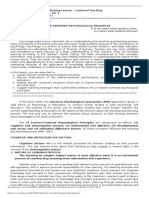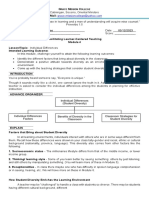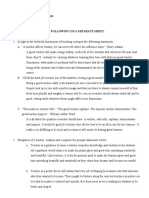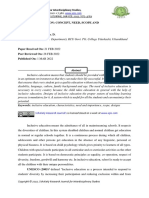PPST
PPST
Uploaded by
drewCopyright:
Available Formats
PPST
PPST
Uploaded by
drewOriginal Description:
Copyright
Available Formats
Share this document
Did you find this document useful?
Is this content inappropriate?
Copyright:
Available Formats
PPST
PPST
Uploaded by
drewCopyright:
Available Formats
PHILIPPINE
NATIONAL
RESEARCH CENTER FOR TEACHER QUALITY
nd
2 Floor, Gusali ng Wika, Philippine Normal University
Taft Avenue corner Ayala Boulevard, Manila
Telefax +632-302-6755 ² Email rctq@pnu.edu.ph
FREQUENTLY ASKED QUESTIONS
on the Philippine Professional Standards for Teachers
General Information on Department Order No. 42, s. 2017
1. What is Department Order (DepEd) No. 42, s. 2017)?
DepEd Order No. 42, S. 2017 stipulates the national adoption and implementation of the Philippine
Professional Standards for Teachers (PPST). The Order was signed on August 11, 2017 by DepEd
Secretary Leonor Magtolis-Briones. See link: http://www.deped.gov.ph/orders/do-42-s-2017
2. What is the Philippine Professional Standards for Teachers (PPST)?
The PPST is a public statement of what teachers need to know, value, and be able to do in their
practice. It has four career stages: Beginning, Proficient, Highly Proficient, and Distinguished. It is
built on the National Competency-based Teacher Standards (NCBTS). It comprises seven Domains
and 37 Strands, and 37 Indicators for each Career Stage.
3. What are uses of the Philippine Professional Standards for Teachers?
According to DO No. 42, s. 2017, the PPST “shall be used as a basis for all learning and development
programs for teachers to ensure that teachers are properly equipped to effectively implement the K
to 12 Program.” Teacher performance appraisals shall also be aligned to the PPST. Further, the PPST
can also be used for the selection and promotion of teachers.
A. Development of the Philippine Professional Standards for Teachers
1. Why was the PPST developed?
The PPST was developed after major consultations with key stakeholders, particularly the senior
officials of the Department of Education. The wide consultations emphasized the rethinking of the
National Competency-Based Teacher Standards (NCBTS) because of changes brought about by
various national and global frameworks such as the K to 12 Reform and ASEAN Integration, as well as
globalization and the changing character of the 21st century learners.
See link: http://www.deped.gov.ph/orders/do-42-s-2017
2. Does PPST replace NCBTS?
Yes. This happens upon the signing into policy of DepEd Order No. 42, S. 2017 on the National
Adoption and Implementation of the Philippine Professional Standards for Teachers.
3. Why do we need the Philippine Professional Standards for Teachers?
Internationally, teacher quality is articulated in teacher standards. The PPST is a framework for
teacher quality and teacher development.
Among others, the Philippine Professional Standards for Teachers can be used in: (i) endorsing
programs for initial teacher education; (ii) registering and accrediting teachers; (iii) raising the quality
of professional learning; (iv) identifying and recognizing exemplary high level practice; (v) developing
standards for leadership; (vi) establishing a consistent evaluation/assessment process associated
with each Career Stage that preserves the integrity of the PPST; and (vii) maintaining an efficient
documentation process associated with achievement of the Indicators across Career Stages.
4. Why focus on teacher quality?
Evidence show unequivocally that good teachers are vital to raising student achievement, i.e.,
quality learning is contingent upon quality teaching. Hence, enhancing teacher quality becomes of
utmost importance for long-term and sustainable nation building.
5. How was the PPST developed?
The Department of Education through the Joint Advisory Board chaired by the Secretary of
Education approved the development and validation of developmental teacher standards
comprising distinct career stages.
The Philippine National Research Center for Teacher Quality (RCTQ) based at the Philippine Normal
University led the research development work, with support from the SiMERR National Research
Centre in Australia.
DepEd Regional Directors, Bureau Directors and selected teachers finalized the PPST in a workshop
organized by the Teacher Education Council, supported by the Basic Education Sector
Transformation program.
6. Were key stakeholders involved in the process of development and validation of the PPST?
Yes. Over 10,000 pre- and in-service teachers, principals, supervisors, DepEd Regional Directors and
other educators across all regions in the country were involved in the development and validation of
the PPST over three years.
Government agencies other than DepEd (e.g., Professional Regulation Commission, Commission on
Higher Education, Civil Service Commission), as well as non-government organizations (e.g.
Philippine Business for Education, Foundation for Upgrading the Standard of Education) were part of
the Reference Panel.
7. Who funded the development of the PPST?
The PPST project was funded by the Australian Department of Foreign Affairs and Trade (DFAT).
DFAT supports the Research Center for Teacher Quality.
B. Important Features of PPST
1. What are some important features of PPST?
The PPST captures teacher quality requirements in the K to 12. Among others, it gives a focus on: (i)
mother tongue to facilitate teaching and learning; (ii) learners in difficult circumstances; (iii)
strategies for promoting literacy and numeracy; (iv) positive use of ICT; and (v) classroom
communication strategies.
PPST has a domain called Content Knowledge and Pedagogy. This is at the core of the K to 12
Program, and sends a message to teachers that for them to be considered quality teachers, they
should know what to teach and how to teach it, among others.
PPST also has four career stages, namely, Beginning, Proficient, Highly Proficient, and Distinguished.
There are 37 indicators in each career stage showing developmental progression from beginning to
distinguished practice.
2. What are the Domains of PPST?
These are the seven Domains of PPST: (1) Content Knowledge and Pedagogy; (2) Learning
Environment; (3) Diversity of Learners; (4) Curriculum and Planning; (5) Assessment and Reporting;
(6) Community Linkages and Professional Engagement; and (7) Personal Growth and Professional
Development.
3. What qualities are expected of teachers based on these Domains of the PPST?
As articulated in the Domains of PPST, teachers must, among others: i) know what to teach and how
to teach it; ii) maintain a learning-focused environment; iii) respond to learner diversity; iv) plan and
design effective instruction; v) use a variety of assessment tools to inform and enhance the teaching
and learning process; vi) establish community relationships and uphold professional ethics; and vii)
engage in professional reflection and assume responsibility for personal professional learning.
4. What are the four Career Stages of the PPST?
Beginning Teachers (Career Stage 1) are those who have gained the qualifications recognized for
entry into the teaching profession. Teachers at this stage are supported to reach Career Stage 2
within two to three years.
Proficient Teachers (Career Stage 2) are professionally independent in the application of skills vital
to the teaching and learning process. This stage shows the acceptable standards for all teachers,
which should be reached within the first two or three years of teaching.
Highly Proficient Teachers (Career Stage 3) consistently display a high level of performance in their
teaching practice. They are accomplished practitioners who mentor and work collegially with other
staff. This is the stage that Master Teachers are expected to be at.
Distinguished Teachers (Career Stage 4) embody the highest standards for teaching grounded in
global best practice. They are recognized as leaders in education, contributors to the profession and
initiators of collaborations and partnerships.
5. Why are Career Stages important?
The description of standards (i.e., in PPST, the indicators) at different career stages provides a
“framework for the teacher development continuum.” (OECD, 2005). Anchored on the principle of
lifelong learning, the PPST recognizes the significance of a standards framework that articulates
developmental progression as teachers develop, refine their practice and respond to the
complexities of educational reforms.
C. Teacher Assessment based on the PPST
1. Are there tools based on PPST that may be used for teacher assessment?
Yes. RCTQ developed teacher assessment tools in partnership with DepEd Bureau of Human
Resource and Organization Development (BHROD) with support from the BEST program. These tools
include: (1) Self-Assessment Tools (SAT); 2) Classroom Observation Tools (COT); and 3) Results-based
Performance Management System (RPMS) Tools for Teachers.
These tools have been rigorously validated.
2. Can we craft our own PPST-based tools?
Yes. But you have to ensure that the tools are based on the PPST, as indicated in DepEd Order No.
42, S. 2017.
You also have to keep in mind that locally produced tools are unlikely to be validated, which may call
the reliability and credibility of their results into question.
3. Can the PPST be used as a rubric to assess teachers’ performance?
The PPST is not a rubric and is not a tool to assess teachers’ performance. However, it can be used as
a framework upon which teacher support tools such as self-assessment tools, classroom observation
tools and RPMS tools can be based.
4. Will teachers be assessed on all indicators? What if a school, for example, has no learners from
indigenous groups?
No. Teachers do not need to be assessed on indicators that do not apply in their school contexts.
In terms of pre-service teachers, however, Teacher Education Institutions (TEIs) are expected to train
them on all indicators to prepare them to handle various teaching contexts.
5. How can we measure the competencies of our teachers in every strand/indicator objectively?
Are there specific means of verification (MOV) for each indicator?
The Results-based Performance Management System (RPMS) Tools based on PPST have specific
MOV for the 12 indicators of the PPST.
The Classroom Observation Tools have specific examples of classroom practice to guide observers.
6. Will PPST assessment tools be used for the hiring and promotion of teachers?
Policies concerning these matters are yet to be developed.
You might also like
- Let's Speak Indonesian! Vol 1Document251 pagesLet's Speak Indonesian! Vol 1scoresForeverNo ratings yet
- Giis Yearbook 2023-24Document54 pagesGiis Yearbook 2023-24Kareesh ShamilsanNo ratings yet
- DLL OrientationDocument2 pagesDLL OrientationMa. Luisa basijan100% (9)
- Startland Annual Report 2022Document21 pagesStartland Annual Report 2022StartlandNo ratings yet
- Mathematics Resource Package: Quarter I Subject: MATH Date: - Day: 3 Content StandardDocument7 pagesMathematics Resource Package: Quarter I Subject: MATH Date: - Day: 3 Content StandardLowie D GacetaNo ratings yet
- HDP Work Book Final HaileDocument139 pagesHDP Work Book Final HaileSimachew Addisu100% (7)
- Course Title Course Code Number of UnitsDocument6 pagesCourse Title Course Code Number of UnitsMingNo ratings yet
- Learner-Centered Psychological PrinciplesDocument25 pagesLearner-Centered Psychological PrinciplesMichael MorenoNo ratings yet
- Benefits and Barriers of Inclusive EducationDocument23 pagesBenefits and Barriers of Inclusive EducationAmparo ZapantaNo ratings yet
- Computer System (Hardware, Software & Peopleware)Document19 pagesComputer System (Hardware, Software & Peopleware)drewNo ratings yet
- Esporna, Gladys Mae L - BEED 2-2 - ELEM 2209 - LO5 HealthDocument26 pagesEsporna, Gladys Mae L - BEED 2-2 - ELEM 2209 - LO5 HealthBasty100% (1)
- PPST NewDocument7 pagesPPST NewDiana MarieNo ratings yet
- Handouts - Curriculum in Schools Week 2Document3 pagesHandouts - Curriculum in Schools Week 2Luke FlukeNo ratings yet
- The Code of Ethics For Professional Teacher1Document5 pagesThe Code of Ethics For Professional Teacher1Kevin LamioNo ratings yet
- National Competency Based Teacher StandardsDocument3 pagesNational Competency Based Teacher StandardsJoboy Fritz75% (4)
- Chapter 1-3-The-Teaching-ProfessionDocument37 pagesChapter 1-3-The-Teaching-ProfessionJoe AmirthamNo ratings yet
- Lesson 2 (Richel Leola Sumagang) PROFEDDocument5 pagesLesson 2 (Richel Leola Sumagang) PROFEDRichel Leola SumagangNo ratings yet
- The Great Plebeian College: Alaminos City, PangasinanDocument1 pageThe Great Plebeian College: Alaminos City, PangasinanPapsNo ratings yet
- Outcome Based EducationDocument13 pagesOutcome Based EducationJoeriza MoldeNo ratings yet
- Philippine Professional Standard For Teachers (PPST)Document19 pagesPhilippine Professional Standard For Teachers (PPST)Pax GarciaNo ratings yet
- Facilitating Learner Centered Teaching O PDFDocument14 pagesFacilitating Learner Centered Teaching O PDFJonnah Faith Mayo BingilNo ratings yet
- FLCT ModuleDocument5 pagesFLCT ModuleThelma GonzalesNo ratings yet
- Assignment - Philosophy in LifeDocument8 pagesAssignment - Philosophy in LifeArjay PascuaNo ratings yet
- IX. Statement of Purpose of The PortfolioDocument2 pagesIX. Statement of Purpose of The PortfolioMaria Karina FerrerasNo ratings yet
- TP ModuleDocument75 pagesTP ModuleZailah BonusNo ratings yet
- Mystical Rose College of Science and Technology Pogonlomboy, Mangatarem, Pangasinan Mobile No.: 0920-964-4762Document2 pagesMystical Rose College of Science and Technology Pogonlomboy, Mangatarem, Pangasinan Mobile No.: 0920-964-4762ciantal batobatoNo ratings yet
- Policy Guidelines On Daily Lesson Preparation For The K To 12 Basic Education ProgramDocument91 pagesPolicy Guidelines On Daily Lesson Preparation For The K To 12 Basic Education ProgramSRANo ratings yet
- 4.7 EssayDocument4 pages4.7 EssayRandy Natal100% (1)
- Alma Euc 111 (To Print)Document4 pagesAlma Euc 111 (To Print)Alma Mae CortezNo ratings yet
- LDM PortfolioDocument19 pagesLDM PortfolioRoxanne Saraza Acuña - Manzanero79% (24)
- Program and Services PDFDocument36 pagesProgram and Services PDFNNo ratings yet
- EDUC 147 Module 4E 1Document17 pagesEDUC 147 Module 4E 1Mark DaveNo ratings yet
- The 21st Century TeacherDocument6 pagesThe 21st Century TeacherAngilly LibreaNo ratings yet
- Personal Qualities of A Good TeacherDocument2 pagesPersonal Qualities of A Good TeacherQin KaiNo ratings yet
- Teaching StrategiesDocument16 pagesTeaching StrategiesGomonan RosannaNo ratings yet
- The Teaching Profession - M2-Learning-Episode-8Document10 pagesThe Teaching Profession - M2-Learning-Episode-8Aprilyn Balacano Valdez NaniongNo ratings yet
- PD MT 2 Managing Multigrade Classroom StudentDocument45 pagesPD MT 2 Managing Multigrade Classroom StudentVanessa V. Rutaquio100% (1)
- Chapter2 The Teacher in The Classroom and CommunityDocument84 pagesChapter2 The Teacher in The Classroom and Communitychristopher d. balubayan100% (1)
- PPSTDocument37 pagesPPSTmia saraba bazar75% (4)
- Identifying Effective TeachingDocument4 pagesIdentifying Effective TeachingCary Jacot SagocsocNo ratings yet
- Module 4Document20 pagesModule 4Frances Bea AbaradoNo ratings yet
- Lesson 5: Cagayan State UniversityDocument15 pagesLesson 5: Cagayan State UniversityAlphà Sumaling100% (1)
- Ed 680 Final Reflection EssayDocument5 pagesEd 680 Final Reflection Essayapi-508948800No ratings yet
- Assessment of Learning Summary / Keyword AssessmentDocument26 pagesAssessment of Learning Summary / Keyword AssessmentMacy ValenzuelaNo ratings yet
- ANGELIC - Salient Features of K To 12 - SPTOPDocument16 pagesANGELIC - Salient Features of K To 12 - SPTOPAngelic AlmaydaNo ratings yet
- MODULE 6 EDUC 012 - The Teaching Profession - FinalDocument14 pagesMODULE 6 EDUC 012 - The Teaching Profession - FinalMargaux Beatrix AsuncionNo ratings yet
- Chapter 1 Lesson 1 An Exercise To Determine Your Educational Philosophy Find Out To Which Philosophy You AdhereDocument24 pagesChapter 1 Lesson 1 An Exercise To Determine Your Educational Philosophy Find Out To Which Philosophy You AdhereMarion LauritoNo ratings yet
- This Study Resource Was Shared Via: Module 3:learning /thinking Styles and Multiple IntelligencesDocument5 pagesThis Study Resource Was Shared Via: Module 3:learning /thinking Styles and Multiple IntelligencesMICHELLE BIANCA PATRICE CRUZNo ratings yet
- Unit I: The Teacher As A Person in Society Unit II: The Teacher in The Classroom and CommunityDocument63 pagesUnit I: The Teacher As A Person in Society Unit II: The Teacher in The Classroom and CommunityJuan Miguel Salvador MaglalangNo ratings yet
- Ttl1 - Unit 3 Lesson 1Document23 pagesTtl1 - Unit 3 Lesson 1Al LaurioNo ratings yet
- Basic Laws On The Professionalization of TeachingDocument86 pagesBasic Laws On The Professionalization of TeachingGrecii SarmientoNo ratings yet
- Benlac Module 4Document30 pagesBenlac Module 4Justine Vistavilla PagodNo ratings yet
- CRIS ANN REYES - Module 4 The Making of A Professional and Glocal TeacherDocument11 pagesCRIS ANN REYES - Module 4 The Making of A Professional and Glocal TeacherCris Ann Dello ReyesNo ratings yet
- Inclusive Education: Concept, Need, Scope and DesignsDocument8 pagesInclusive Education: Concept, Need, Scope and DesignsAnonymous CwJeBCAXpNo ratings yet
- Module in Building Enhancing New Literacies Across The Curriculum W/ Emphasis On The 21St Century SkillsDocument5 pagesModule in Building Enhancing New Literacies Across The Curriculum W/ Emphasis On The 21St Century Skillskyla lalaine albertoNo ratings yet
- Teacher Education For Mother Tongue - Based Education ProgramsDocument15 pagesTeacher Education For Mother Tongue - Based Education ProgramsLuke SueNo ratings yet
- Portfolio Draft1Document42 pagesPortfolio Draft1Chi ZuNo ratings yet
- EDUC 213 - QuizDocument5 pagesEDUC 213 - QuizFe CanoyNo ratings yet
- SMDLozano - Student Teaching PortfolioDocument71 pagesSMDLozano - Student Teaching PortfolioMarc AcbanginNo ratings yet
- Ariane Rose Angelie P. Tolosa Educ 219 Dipt-4-SDocument3 pagesAriane Rose Angelie P. Tolosa Educ 219 Dipt-4-Sjoan sabranNo ratings yet
- Magna Carta and Code of EthicsDocument60 pagesMagna Carta and Code of EthicsMac RenoNo ratings yet
- An Exercise To Determine Your Educational PhilosophyDocument3 pagesAn Exercise To Determine Your Educational PhilosophyJonalyn CandilasNo ratings yet
- A Preliminary ActivityDocument2 pagesA Preliminary ActivityJacquilou SalalimaNo ratings yet
- Educ 3 Modyul FOR STUDENTDocument67 pagesEduc 3 Modyul FOR STUDENTThereze CedeñoNo ratings yet
- BLAYA, PJ - Module 5 - Lesson 6Document2 pagesBLAYA, PJ - Module 5 - Lesson 6Phranxies Jean Blaya100% (1)
- My Prototype Rubrics 1Document91 pagesMy Prototype Rubrics 1Poe Peligrino-Felisilda Bagarinao Jr100% (2)
- Rizal FinalDocument28 pagesRizal FinalLigutan Merade AmarilloNo ratings yet
- Enhancing Competency of Teachers: A Teaching-And-Learning Enhancement GuideFrom EverandEnhancing Competency of Teachers: A Teaching-And-Learning Enhancement GuideNo ratings yet
- MAALAMATH LAC Session Proposal On Creating Video Lesson Using Powerpoint PresentationDocument12 pagesMAALAMATH LAC Session Proposal On Creating Video Lesson Using Powerpoint PresentationdrewNo ratings yet
- Sptve: Internet and Computing Fundamentals 8Document15 pagesSptve: Internet and Computing Fundamentals 8drewNo ratings yet
- Verline B. Villon: TeacherDocument20 pagesVerline B. Villon: TeacherdrewNo ratings yet
- St. Paul University Philippines: Tuguegarao City, Cagayan 3500Document11 pagesSt. Paul University Philippines: Tuguegarao City, Cagayan 3500drewNo ratings yet
- School Grade Level Teacher Learning Area Date Quarter: Internet and Computer FundamentalsDocument6 pagesSchool Grade Level Teacher Learning Area Date Quarter: Internet and Computer FundamentalsdrewNo ratings yet
- Code Course Title Units Instructor Institutional Course BRIDGE COURSE (9 Units)Document1 pageCode Course Title Units Instructor Institutional Course BRIDGE COURSE (9 Units)drewNo ratings yet
- Allacapan Vocational High School Allacapan, CagayanDocument1 pageAllacapan Vocational High School Allacapan, CagayandrewNo ratings yet
- The Impact of English Subject On The StudentDocument14 pagesThe Impact of English Subject On The StudentFatima LeyNo ratings yet
- Towards Inclusion - From Challenges To Possibilities - Planning For BehaviourDocument215 pagesTowards Inclusion - From Challenges To Possibilities - Planning For BehaviourWilson Luis SilvaNo ratings yet
- Haley Pettit ResumeDocument1 pageHaley Pettit Resumeapi-360933060No ratings yet
- Final Test Design and Framework For The Ethiopian School SupervisorsDocument12 pagesFinal Test Design and Framework For The Ethiopian School Supervisorseyaluayssa10qNo ratings yet
- Causes and Consequences of Workplace Stress Among Pakistan UniversityDocument17 pagesCauses and Consequences of Workplace Stress Among Pakistan UniversityHidayanti Hj AhmadNo ratings yet
- Student-Led ConferenceDocument9 pagesStudent-Led ConferenceDEZA NUR CAHYANING TIYAS -No ratings yet
- Practical Research Chapter 12 3Document24 pagesPractical Research Chapter 12 3Cade HelliosNo ratings yet
- 30 Đề Speaking VSTEP Part 1 3Document37 pages30 Đề Speaking VSTEP Part 1 3Nguyễn Thùy TrangNo ratings yet
- Mathematics FPDDocument19 pagesMathematics FPDapi-357680810No ratings yet
- Shihong Xus Updated ResumeDocument3 pagesShihong Xus Updated Resumeapi-469710033No ratings yet
- 150 Actual Board 2022 MarchDocument194 pages150 Actual Board 2022 MarchClifford LightNo ratings yet
- ILP Spring 2021Document7 pagesILP Spring 2021Charles OestreicherNo ratings yet
- Quarter 2 PE 7 Week 1Document2 pagesQuarter 2 PE 7 Week 1jonalyn obinaNo ratings yet
- English: Quarter 2 - Module 6: Word AnalogiesDocument31 pagesEnglish: Quarter 2 - Module 6: Word AnalogiesMarissa Urnos100% (1)
- Lesson Section.: Week 1: School-Based Assignments For Student Teacher Dear StudentDocument11 pagesLesson Section.: Week 1: School-Based Assignments For Student Teacher Dear Studentafia afiaNo ratings yet
- Curriculum ProposalDocument4 pagesCurriculum ProposalBae Joo HyunNo ratings yet
- Ced110 - Building and Enhancing New Literacies Across The CurriculumDocument13 pagesCed110 - Building and Enhancing New Literacies Across The CurriculumJuly PontilloNo ratings yet
- Applying Behavior Analytic Procedures To Effectively Teach Literacy Skills in The ClassroomDocument17 pagesApplying Behavior Analytic Procedures To Effectively Teach Literacy Skills in The ClassroomCaptaciones CDU CanteraNo ratings yet
- Invigorating Economic Confidence in Malaysia - G25 ReportDocument92 pagesInvigorating Economic Confidence in Malaysia - G25 ReportSweetCharity77No ratings yet
- Soundscape MatrixDocument4 pagesSoundscape Matrixapi-297709527No ratings yet
- Abstracts Muspedsymp2018dec BPDocument44 pagesAbstracts Muspedsymp2018dec BPMohamad IbrahemNo ratings yet
- Science Assign 2Document34 pagesScience Assign 2api-527229141No ratings yet
- Teaching Grammar Using MusicDocument8 pagesTeaching Grammar Using MusicazimahsallehNo ratings yet

































































































